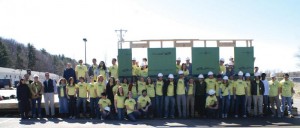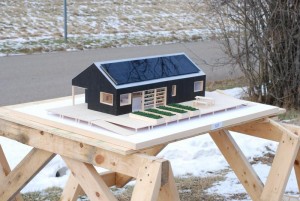Middlebury Students Practice “Self-Reliance” With Solar Decathlon House
Thursday, April 21, 2011By April Saylor
Editor’s Note: This entry has been cross-posted from DOE’s Energy Blog.
In honor of the U.S. Department of Energy Solar Decathlon—which challenges 20 collegiate teams to design, build, and operate solar-powered houses that are cost-effective, energy-efficient, and attractive—we are profiling each of the 20 teams participating in the competition.
Located in Vermont’s Champlain Valley, with the Green Mountains to the east of campus and the Adirondacks to the west, Middlebury College seems like a naturally suited location for a Solar Decathlon team. For decades, the school has made sustainability a priority, and it launched the first environmental studies major in the nation in 1965. Since then, new buildings built on campus have incorporated energy-saving features and used sustainable and recycled materials. Middlebury’s Franklin Environmental Center received a LEED Platinum award for its environmental design, and the school has committed to become carbon-neutral by 2016. The campus also houses a new biomass plant, which boasts a gasification system that converts regionally grown wood chips into gas, which it then burns to provide steam for heating, cooling, hot water, and cooking throughout the campus.
With all this focus on sustainability, it should come as no surprise that, two years ago, Architectural Studies major Addison Godine and three other students created a proposal for the Solar Decathlon competition. Since then, the team has worked long hours together and grown to a group of more than 75 students from across 18 majors.

The Middlebury team at its recent “wall-raising” event. (Courtesy of the Middlebury Solar Decathlon team)
We spoke with Addison, the team’s student project lead, and Melissa Segil, the team manager and an International Politics and Economics double major to find out more about the team and its design.
The house, which the team named Self-Reliance after the essay by Ralph Waldo Emerson, was inspired by the design of a traditional New England farmhouse. The team is using only natural building materials, including sustainably harvested wood from local forests, recycled insulation, and natural finishes and paints. The house also uses high-performance, triple glazed windows with insulated frames that will maximize the amount of natural light allowed in.
The goal of the Middlebury team has been to produce an affordable house that is both functional and comfortable for a family of four. Although the house is smaller than the average American home, the team has maximized its square footage by creating two distinct zones that separate the “public” area from the “private.” The public space contains a greenhouse and a kitchen and dining area for food preparation for the family and its guests. Two bedrooms are located in the more private side of the house. The house has an “as-built” budget of less than $250,000—an impressive feat.
Addison says the best part of the Solar Decathlon experience so far has been the ability to work with a group of students in the college atmosphere that are “dedicated to a project because they believe in it, not because they have to participate for a class.”
Melissa says she has really enjoyed the outreach that the project involves.
“It’s been awesome to be able to share the process with the community,” she says. “We’ve held open houses and symposiums, and it’s been really fun to be able to tell other people about the project and hear from excited parents, grandparents, and others in the Middlebury community.”
Both Addison and Melissa say the team has run across a few challenges, including the fact that the small liberal arts college is one of few in the competition without a professional architecture program. But the team has persevered. They’ve powered through a major design change and seen cycles of students come and go. (Many Middlebury students study abroad during their undergraduate years.)
Aside from the challenges, Melissa is happy to report that the team recently began construction on the house over the school’s spring break. “We’re really having a blast now that construction has started,” she says.
After the conclusion of the competition, the Middlebury team plans to bring the house back from Washington, D.C., to the Middlebury campus. Melissa says the house will become a residence for students and simultaneously serve as an environmental outreach center that will host events to promote sustainability.
To learn more about Self-Reliance and the Middlebury College team, visit its website, where you can read its blog or see videos that the team has made.
April Saylor is an online content producer and contractor to the Department of Energy Office of Public Affairs.
Tags: Middlebury College, Solar Decathlon, Solar Decathlon 2011, Teams

